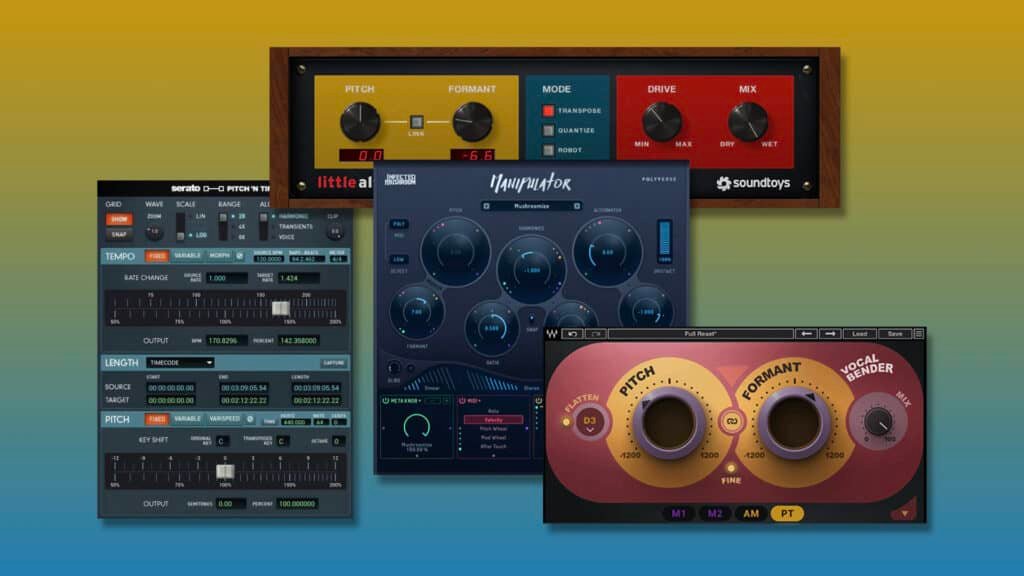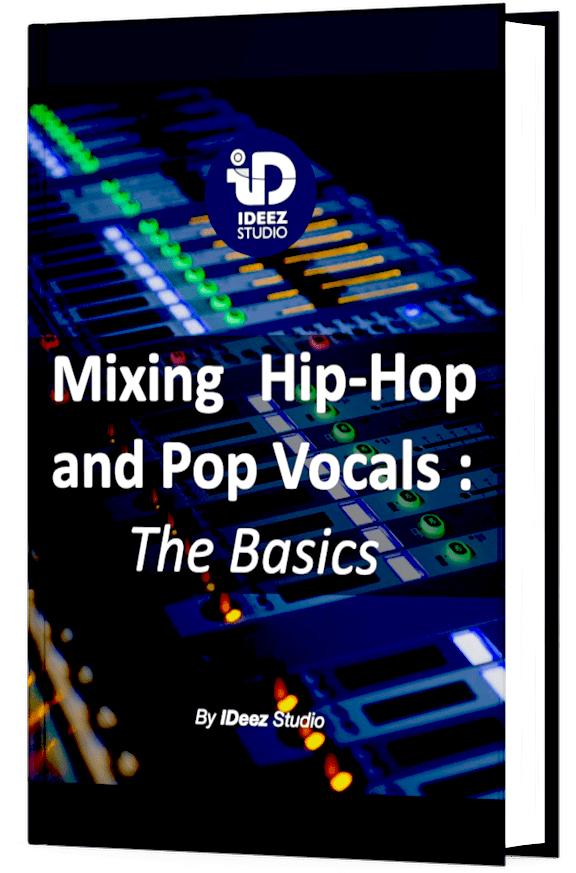Pitch shifter, an audio tool originally designed for correction, has been used more and more creatively in recent years by producers and sound engineers around the world. But what is it exactly ? And how do you use it with vocals ? Everything you need to know can be found here.

A pitch shifter is a tool that modifies the pitch of an audio source. It is usually used with monophonic melodic instruments. It can exist in a digital form (plugin) or in a hardware form (pedal). The tonal modification tool can be used in octaves, semitones or cents.
What A Pitch shifter is
The definition of a pitch shifter is obviously not sufficient to describe how this kind of tool works and how to use it. Some of the terms may also be a little fuzzy in your mind. This is normal!
Let’s take a quick look at the important vocabulary that will help us to describe this tool.
- Pitch : Term that refers to the frequency of a note. The higher a note is, the higher the pitch.
- Cent : These are hundredths of semitones.
- Semitone : Interval that separates each note of the scale. There are 12 in an octave.
- Octave : Interval that separates a note from half (lower) or double (higher) of it.
- Formant* : Maximum resonance frequency of the spectral envelope of the speech signal at a given time.
*Note : Formant is often a misunderstood term due to its rather complicated definition. But put in a situation, it is very easy to understand. It is a bit like comparing two singers singing in unison, one with a low voice and the other with a high one. With the same note, one of them will sound lower, because the envelope is not the same.
The cent is not really a scale in itself, but rather a benchmark for fine tuning.

Need a professional sound engineer specializing in pop and hip-hop mixing ? Great! Just take a look at our services and let’s blow up your career together! Let’s start now!
But how is it possible to change the pitch, in other words, the frequency of a source? In fact, all pitch shifting tools use different algorithms to perform pitch shifting. But the principle remains the same: Modify the waveform.
The pitch shifter will either crush/shorten the wavelength to make it more high-pitched, or extend
it to make it more low-pitched.
In other words, the leaner the waveform looks, the more the audio source is pitched towards the high notes. The wider the waveform looks, the more the source is pitched towards the lower frequencies. Let’s illustrate this principle with pictures and audio.
This is our initial signal

Keep your attention on the wavelength. In other words, the space between each peak.
This is our high-pitched signal

The wavelength completely changed. It has been modified by the pitch shifter. The space between each peak is much tighter. As the wavelength is shorter, the note, and the pitch, is higher.
And this is our low-pitched signal

The wavelength has completely widened, that’s why the note is lower.
A short historical break
Already in the 1940s, the pitch system was used in the film world, slowing down or speeding up the tapes, creating a “natural” and analog pitch.
In the world of music, it was a few years later that the principle of pitch shifting was used by the Beatles. At least that’s what history will remember.
But at that time, this principle of mixing and production remained very technical and not very creative. It is only a few decades later, in the 90s, that the situation changes. And more precisely, in 1997.
That year, a revolution in vocal mixing emerged: autotune. Although autotune is not a pitch shifter in the true sense of the word, it will unleash the creativity of the community of artists, producers and sound engineers around the world.
The entire creative landscape behind the human voice is explored! Artists and producers such as Kanye West, T-Pain or, later, the Black Eyed Peas will push the pitch shifting tool to the extreme, making it one of the most used creative tools in music.
How to use with vocals
The instrument on which the pitch shifter is most often used is probably the voice. Let’s not forget that, of all the instruments in the world, the voice is undoubtedly the most elaborate, complete and creative one. This is even more true since softwares technologies have become a standard in the audio world.
Nowadays, the applications of the pitch shifter on vocals are multiple. It would take a whole book to list them all. But let’s take a closer look at the main avenues you can explore.
A. “Demon” voice
This principle of pitch shifting is often used in rap music, to bring out, generally, a machiavellian, dark side, or sometimes to simply give more warmth and charisma.
The way to achieve this is to lower the pitch control until the voice is so low that it sounds almost demonic. We can usually go down until one octave, so that it stays in harmony with the dry signal.
This should not be overdone, as it will bore the listener and completely ruin the surprise effect. Here’s an audio example :
The combination of the unpitched voice with the down-pitched voice brings out something very powerful.
As you can hear in this audio clip, the effect is used in parallel, which means that we have, at a similar level, the direct signal of the voice and the processed signal.
You can also hear that the effect is not in the middle, but on the extreme left-right of the stereo image. Using a doubler or chorus can be very interesting with this kind of effect.
B. “Chipmunk” Voice
The principle is exactly the same as with the “demon” voice, the only difference being that instead of lowering the pitch pot by an octave, it must be raised.
You might ask yourself: At what point, and in what situation, will I use this principle? In fact, this kind of upward pitch effect is very effective in rap music (yes, again!) and especially in phases where the rapper would speed up the flow of his/her lyrics. This increases the feeling of speed, but can also support the rapper’s insolence, if that is the artist’s goal.
If you wish to listen to audio examples, I advise you to listen to more technical freestyles of rappers like Token or 6ix9ine, you will certainly find very quickly this kind of chipmunk voice associated with their ultra fast flow.
C. Harmonies
If you know the scale of the piece you are working on, you can target strategic semitone intervals to create harmonies. On songs with long, melodic syllables, this effect can sometimes bring a lot of magic.
But it’s still important to do this kind of thing with precision. Each interval brings out emotions, positive or negative. So before choosing the interval of your pitch shifter, you should first ask yourself: what are my mixing intentions? What emotion do I want to bring out?
Depending on the answer, you will choose the most suitable note(s) to put in parallel with the unprocessed voice.
D. Manual Vocal Synthesizer
Many pitch shifting plugins allow you, instead of changing each note relatively, to target an absolute note. No matter what note is played, the targeted frequency will always be the one that is played.
This allows, with a little automation work and with several duplicated tracks, to create chord progressions based on a single voice, which is in fact, more or less, the principle of a vocal synthesizer.
The magic with this mixing / production principle is the freedom you have to make the chords you want to go with the lead voice. This is obviously a risk if you don’t know much about music theory, but it’s worth a try in atmospheric tracks!
E. Be Creative!
The pitch shifting principles presented in this article represent only a tiny fraction of the creative choices available in today’s plugins and tools.
With the ability to change the pitch of a voice, think of all the things you can create. It’s limitless!
Tweak the knobs, go extreme, get inspired, and the quality of your music will only increase.
6 Ways To Be More Creative In Vocal Mixing
Would you like to bring out more creativity in your vocal mixes? Check this article!
The best plugins for pitch shifting
As in every subfield of vocal mixing in the music world, some tools are much more suitable than others.
The choice of plugin is of course very subjective. It depends on your taste and the workflow you use to mix or produce music. But it’s always interesting to have a few hints to make a precise research.
A. Little AlterBoy (Soundtoys)

In the last few years, Little AlterBoy has become one of the most used pitch shifters in the music mixing field.
This plugin has indeed everything to please. First of all, it is extremely instinctive and easy to use. Contrary to some plugins full of knobs everywhere, Little AlterBoy offers a clean interface that allows the user to develop its ideas quickly.
The Soundtoys plugin also has the advantage of having a high quality sound. And for a pitch shifting plugin, that’s very rare! By playing with all the knobs at your disposal and/or taking inspiration from the presets available with the plugin, the result is guaranteed!
B. Manipulator (Infected Mushroom)

In terms of interface and ease of use, Manipulator is the total opposite of Soudtoys’ plugin. The number of modifiable parameters is huge and the tool is not easy to use. It will certainly take some time to learn how to use it and master it completely.
But the clarity and the purity of the sound result is really worth it. With this plugin in your hands, you will have no limits in your creativity!
Why do you want to use it? Because the manufacturer has implemented tools like an FM oscillator, a sequencer and lots of MIDI detection options.
Besides being of high quality, the sound result is very atypical and different from what we usually hear.
C. Pitch ‘N Time (Serato)

If you’re not really interested in the creative aspect and want to put sound quality first, Pitch ‘N Time is the plugin you need.
Indeed, its ultra powerful algorithm allows to keep an incomparable sampling quality. In purely technical terms, it is the best. But Serato’s plugin still has some flaws.
First of all, it can only be used with Pro Tools. This makes this plugin a very inclusive tool. Second, it is extremely expensive: $800. This is, in my opinion, way too expensive, even for a quality plugin. And finally, it offers very few creative options, every parameter is dedicated to something technical.
D. Vocal Bender (Waves)

In terms of sound quality, Vocal Bender is not the best. Even if, honestly, it remains of good quality. But if you want to learn pitch shifting, it’s the best option. For two reasons.
The first is simply the very affordable price of the Waves plugin: $30. That’s a lot less than all its competitors.
It is easy to use, while having implemented an expert interface that allows you to go further into the available options of the plugin
Conclusion
Initially created for correction purposes, the pitch shifter is now one of the most creative tools in vocal mixing and production. Nowadays, especially in pop music, the voice is more and more considered as a creative instrument in its own right. So it’s up to us, mixing engineers, producers and artists, to use the principle of pitch shifting to explore all the creative possibilities that the human voice offers.
Whatever the plugin used, there will always be a way to create an original universe with a pitch shifter. Don’t just limit yourself to pitch shifting, look further! Use the presets and options at your disposal to break the limits of creativity.
If you have any questions about this topic or anything in the field of music mixing, please contact me, I’m always very happy to help!







